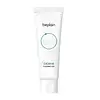What's inside
What's inside
 Key Ingredients
Key Ingredients

 Benefits
Benefits

 Concerns
Concerns

No concerns
 Ingredients Side-by-side
Ingredients Side-by-side

Water
Skin ConditioningPropanediol
Solvent1,2-Hexanediol
Skin ConditioningCentella Asiatica Extract
CleansingTromethamine
BufferingAcrylates/C10-30 Alkyl Acrylate Crosspolymer
Emulsion StabilisingGlycerin
HumectantCarbomer
Emulsion StabilisingHydroxyacetophenone
AntioxidantButylene Glycol
HumectantEthylhexylglycerin
Skin ConditioningDisodium EDTA
Hydrogenated Lecithin
EmulsifyingFicus Carica Fruit Extract
HumectantUlmus Davidiana Root Extract
Skin ConditioningSecale Cereale Seed Extract
AbrasiveCeramide NP
Skin ConditioningTocopherol
AntioxidantWater, Propanediol, 1,2-Hexanediol, Centella Asiatica Extract, Tromethamine, Acrylates/C10-30 Alkyl Acrylate Crosspolymer, Glycerin, Carbomer, Hydroxyacetophenone, Butylene Glycol, Ethylhexylglycerin, Disodium EDTA, Hydrogenated Lecithin, Ficus Carica Fruit Extract, Ulmus Davidiana Root Extract, Secale Cereale Seed Extract, Ceramide NP, Tocopherol
Water
Skin ConditioningDipropylene Glycol
HumectantGlycerin
HumectantPropanediol
SolventPEG-8
HumectantSodium Acrylates Crosspolymer-2
AbsorbentMethyl Gluceth-10
EmulsifyingPEG/PPG-14/7 Dimethyl Ether
Skin ConditioningAmmonium Acryloyldimethyltaurate/Beheneth-25 Methacrylate Crosspolymer
Emulsion StabilisingDimethicone
EmollientPentaerythrityl Tetraethylhexanoate
EmollientDiphenylsiloxy Phenyl Trimethicone
Skin ConditioningPhenoxyethanol
PreservativeMethylparaben
PreservativeMicrocrystalline Cellulose
AbsorbentSodium Metabisulfite
AntioxidantDisodium EDTA
Honey
HumectantOryza Sativa Germ Oil
EmollientSodium Hyaluronate
HumectantSodium Acetylated Hyaluronate
HumectantButylene Glycol
HumectantSericin
Skin ConditioningCitric Acid
BufferingPotassium Sorbate
PreservativeRosa Roxburghii Fruit Extract
TonicTocopherol
AntioxidantSoluble Collagen
HumectantWater, Dipropylene Glycol, Glycerin, Propanediol, PEG-8, Sodium Acrylates Crosspolymer-2, Methyl Gluceth-10, PEG/PPG-14/7 Dimethyl Ether, Ammonium Acryloyldimethyltaurate/Beheneth-25 Methacrylate Crosspolymer, Dimethicone, Pentaerythrityl Tetraethylhexanoate, Diphenylsiloxy Phenyl Trimethicone, Phenoxyethanol, Methylparaben, Microcrystalline Cellulose, Sodium Metabisulfite, Disodium EDTA, Honey, Oryza Sativa Germ Oil, Sodium Hyaluronate, Sodium Acetylated Hyaluronate, Butylene Glycol, Sericin, Citric Acid, Potassium Sorbate, Rosa Roxburghii Fruit Extract, Tocopherol, Soluble Collagen
 Reviews
Reviews

Ingredients Explained
These ingredients are found in both products.
Ingredients higher up in an ingredient list are typically present in a larger amount.
Butylene Glycol (or BG) is used within cosmetic products for a few different reasons:
Overall, Butylene Glycol is a safe and well-rounded ingredient that works well with other ingredients.
Though this ingredient works well with most skin types, some people with sensitive skin may experience a reaction such as allergic rashes, closed comedones, or itchiness.
Learn more about Butylene GlycolDisodium EDTA plays a role in making products more stable by aiding other preservatives.
It is a chelating agent, meaning it neutralizes metal ions that may be found in a product.
Disodium EDTA is a salt of edetic acid and is found to be safe in cosmetic ingredients.
Learn more about Disodium EDTAGlycerin is already naturally found in your skin. It helps moisturize and protect your skin.
A study from 2016 found glycerin to be more effective as a humectant than AHAs and hyaluronic acid.
As a humectant, it helps the skin stay hydrated by pulling moisture to your skin. The low molecular weight of glycerin allows it to pull moisture into the deeper layers of your skin.
Hydrated skin improves your skin barrier; Your skin barrier helps protect against irritants and bacteria.
Glycerin has also been found to have antimicrobial and antiviral properties. Due to these properties, glycerin is often used in wound and burn treatments.
In cosmetics, glycerin is usually derived from plants such as soybean or palm. However, it can also be sourced from animals, such as tallow or animal fat.
This ingredient is organic, colorless, odorless, and non-toxic.
Glycerin is the name for this ingredient in American English. British English uses Glycerol/Glycerine.
Learn more about GlycerinPropanediol is an all-star ingredient. It softens, hydrates, and smooths the skin.
It’s often used to:
Propanediol is not likely to cause sensitivity and considered safe to use. It is derived from corn or petroleum with a clear color and no scent.
Learn more about PropanediolTocopherol (also known as Vitamin E) is a common antioxidant used to help protect the skin from free-radicals and strengthen the skin barrier. It's also fat soluble - this means our skin is great at absorbing it.
Vitamin E also helps keep your natural skin lipids healthy. Your lipid skin barrier naturally consists of lipids, ceramides, and fatty acids. Vitamin E offers extra protection for your skin’s lipid barrier, keeping your skin healthy and nourished.
Another benefit is a bit of UV protection. Vitamin E helps reduce the damage caused by UVB rays. (It should not replace your sunscreen). Combining it with Vitamin C can decrease sunburned cells and hyperpigmentation after UV exposure.
You might have noticed Vitamin E + C often paired together. This is because it is great at stabilizing Vitamin C. Using the two together helps increase the effectiveness of both ingredients.
There are often claims that Vitamin E can reduce/prevent scarring, but these claims haven't been confirmed by scientific research.
Learn more about TocopherolWater. It's the most common cosmetic ingredient of all. You'll usually see it at the top of ingredient lists, meaning that it makes up the largest part of the product.
So why is it so popular? Water most often acts as a solvent - this means that it helps dissolve other ingredients into the formulation.
You'll also recognize water as that liquid we all need to stay alive. If you see this, drink a glass of water. Stay hydrated!
Learn more about Water